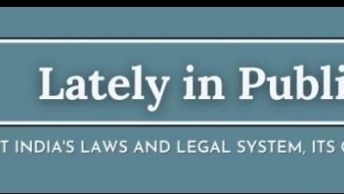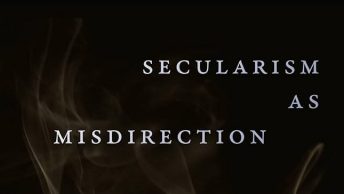Now let us consider how the Court considered the stay issue. Their only concern is this: “What may have been relevant in 1931 Census may have some relevance but cannot be the determinative factor.” The Central Government’s counter-affidavit shows how flawed this concern is. The 1931 Census was not the basis for identification of OBC castes. The GOI’s OBC lists include castes which are common to both the Mandal and the States’ lists. In other words, Mandal list alone is not sufficient. In effect, it is the states’ lists which have been accepted by the Central Govt. The states’ lists have undergone the tests of judicial scrutiny in many cases, and have not been struck down for want of uptodate data.
The court prima facie assumes that inclusion of castes in the OBC list has been mechanical, and done without adequate relevant data. This is a wrong assumption. The inclusion of castes has been going on for many years in various States, on a variety of criteria. The Mandal Commission followed its own criteria, (not on the basis of 1931 census) including representation from the claimant castes, field visits by the Members, and the States’ lists. Now, it is possible that some castes in the lists ceased to be socially and educationally backward, and there could have been mistakes and imperfections while including certain castes, as it could happen in a gigantic exercise like this. Even if there is a caste census, it could happen.
That is why the National Commission for Backward Classes Act, 1993 set up in pursuance of the Indra Sawhney judgment, provides a mechanism to rectify such aberrations. Anyone aggrieved with these lists, could approach the Commission stating the facts, and the nature of the complaint, with documentary evidence, if any for inclusion or exclusion. The Commission’s advice in this regard is binding on the Government. For this, one need not wait for 10 years. The Act also envisages once in a 10-years revision of the lists. This was complied with in 2003, when the Commission advised the Government after a revision, that there was no scope for excluding any classes from the list as the reservation was only introduced very recently after the implementation in services in 1993. In the case of educational institutions, it had not even started. So the question of revision did not arise. Strangely, the Court did not at all fault the petitioners for not using this grievance redressal mechanism under the NCBC Act. All these are to be found in the counter-argument. But for strange reasons, the Court did not address these issues at all in its judgment. Is it a case of selective consideration “on merits”?
I am unable to convince myself that it is a case of the Court hearing it on merits. Even if it had heard it on merits, I am unable to understand why the questions of balance of convenience and presumption of constitutionality are irrelevant. “Elaborate” order, ipso facto, cannot suggest that it was heard on merits. Did the Court seriously go into the merits or non-merits of stay? Instead, it raised extraneous issues like data collection and creamy layer, (on which it was not convinced itself, as it admitted there is need for detailed hearing), and on the basis of their superficial understanding (not even is there any prima facie finding), it proceeds to grant a partial stay.
Here, I would like to correct Mr.Vivek Reddy. The court did not say that the Act is unconstitutional as of today. It is not even sure of this; that is why it has adjourned the case to August for a detailed hearing, clearly showing that its elaborate hearing for the interim stay is not at all sufficient. If the government comes up with fresh evidence, and the Court upholds the Act, will it then compensate the OBCs who lost one academic year, because of its faulty stay of S.6 of the Act?
To put it differently, can Mr.Vivek Reddy as an example, demonstrate what sort of hard data could be convincing to show that the currently listed OBCs are SEBCs. The very inclusion of these castes in the lists carries with it a history of social and educational backwardness – if not a history of discrimination and deprivation as the SCs and STs – as documented by their representations to the Government, demands etc. I fail to understand how such data could be meaningful and convincing through data collection organized in terms of national surveys or censuses. Considering the backwardness and poverty level, it would not be surprising if the people fudge facts, or make spurious claims about their backwardness. The result would not only be confusing, but disastrous. Just one instance will explain. The reservations were first introduced in 1902 and 1921 respectively in princely states of Kolhapur and Mysore, in response to the local movements against existing caste based monopoly. Those princely states did not go about collecting data, but responded immediately to the demands, in order to prevent social unrest. Similarly, if the modern-day governments instinctively, and by way of impulse and formal and informal studies consider a caste as backward, such consideration can be largely respected, with due regard to a few exceptions, which can be tackled through the NCBC Act. It is naïve to believe that large-scale surveys, which the Court has in mind, would be able to help us have fool-proof OBC lists.
Mr.Reddy himself agrees that the question of overall OBC population is not directly relevant when it comes to educational institutions. Does he not agree that the Court is essentially mistaken when it cites different figures of OBC population, as given by different agencies to underline its data-quest? In my view, surveys conducted on a large scale are not the answer to determine whether a caste is SEBC. The answer has to be found in anthropology and sociology, not in statistics.
examination and some arguablepoint is raised, which persuades the courts to consider the controversy,the legislative will should not normally be put under suspension pending such consideration. It is now well-settled that there is always apresumption in favour of the constitutional validity of any legislation,unless the same is set-aside after final hearing and, therefore, the tendency to grant stay of legislation relating to economic reform, at the
interim stage, cannot be understood. The system of checks and balances has to be utilised in a balanced manner with the primary objective of accelerating economic growth rather than suspending its growth by doubting its constitutional efficacy at the threshold itself. While the courts should not abrogate its duty of granting interim injunctions where necessary, equally important is the need to ensure that the judicial discretion does not abrogate from the function of weighing the overwhelming public interest in favour of the continuing operation of a fiscal statute or a piece of economic reform legislation, till on a mature consideration at the final hearing, it is found to beunconstitutional. It is, therefore, necessary to sound a word of cautionagainst intervening at the interlocutory stage in matters of economicreforms and fiscal
statutes.”






Dear Mr. Venkatesan
I appreciate your thoughtful response. You have touched on a range of issues and I will post a response to this shortly.
I believe the bloggers at blogbharti misquoted you:
“He goes on to conclude that the judgement is illegal.”
http://www.blogbharti.com/shivam/india/the-illogic-of-the-data-logic/
You concluded that the stay is unjustified, a perfectly valid and reasonable opinion. They claim you termed the judgement illegal. This is contempt of court.